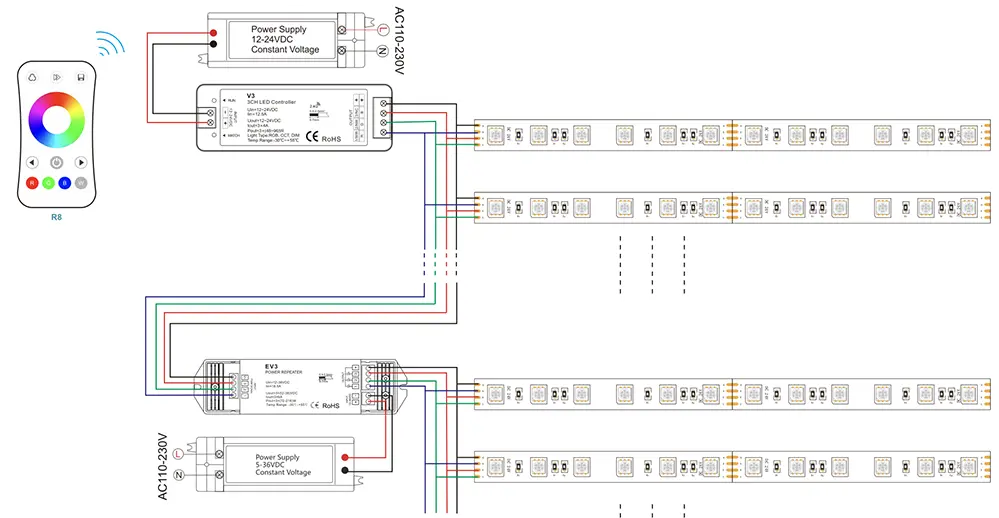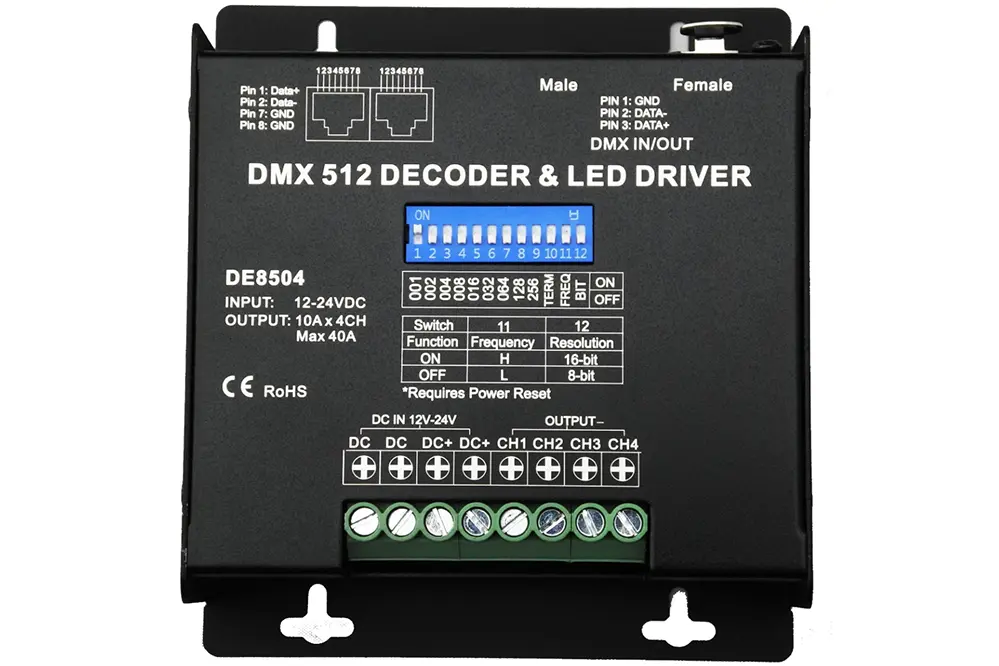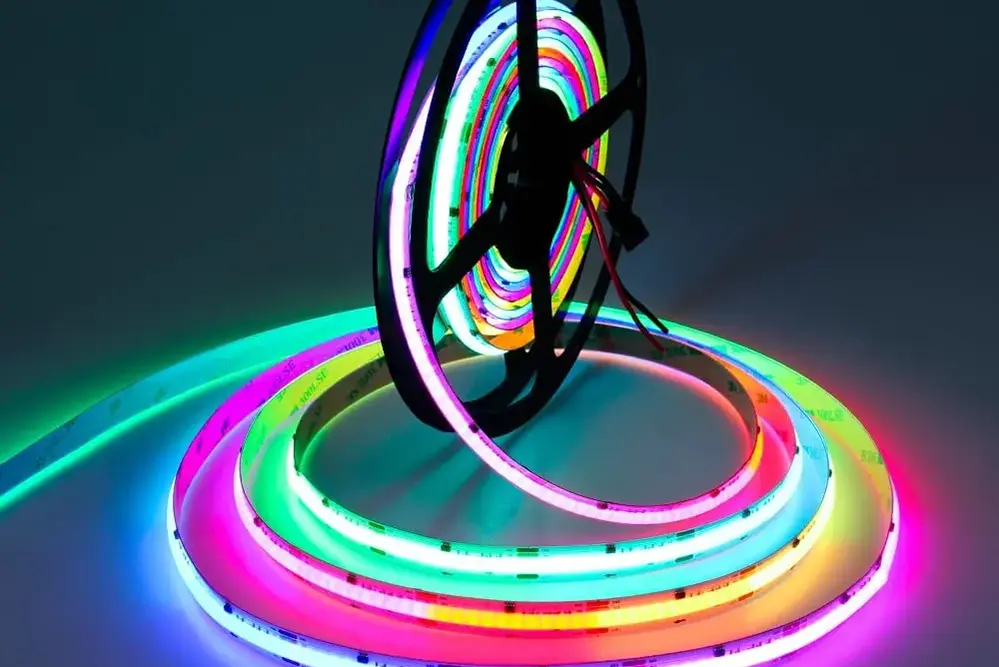In the world of LED strip lights, the difference between 8-bit and 16-bit control can be as striking as night and day. Imagine walking into a room where the lighting seamlessly transitions through a spectrum of colors, creating an atmosphere that feels almost magical. This captivating experience is often the result of precise control over LED lighting, a feat made possible by understanding the nuances between 8-bit and 16-bit systems.
The importance of mastering this distinction cannot be overstated. According to recent studies, lighting quality can significantly impact mood and productivity, with advanced control systems offering a more refined and customizable lighting experience. Surprisingly, many people are unaware of how these two control methods differ and the profound effects they can have on lighting design.
As we delve deeper into this topic, you’ll discover how these control systems can transform your lighting projects, offering unparalleled flexibility and creativity. Join us as we explore the key differences and unlock the potential of LED strip lights.
Understanding LED Strip Controls

Understanding LED strip controls is essential for maximizing the potential of your lighting applications.
LED strips are more than mere lights; they are dynamic elements integral to modern aesthetics, often working in tandem with other fixtures. Transcending simple illumination, these strips offer versatile functionality that can be precisely manipulated through advanced control systems, transforming spaces with vibrant, mood-setting displays.
At the heart of these systems are key technologies—8-bit and 16-bit controls—that dictate the frequency, granularity, and responsiveness of your lighting effects. These controls manage the nuances of colour, dimming, and brightness, empowering users to cultivate immersive environments that resonate with your vision.
The choice between 8-bit and 16-bit control systems impacts the richness and depth of color transitions. An 8-bit system provides 256 levels per channel, while a 16-bit system offers a staggering 65,536 levels, enabling smoother fades and richer hues.
By mastering LED strip controls, you unlock the full spectrum of possibilities, elevating your lighting projects from conventional to extraordinary.
Basics of 8-Bit Control
An 8-bit control system signifies an entry point, offering foundational capabilities in managing LED lighting effects.
In practical terms, an 8-bit system works with 256 distinct levels of brightness per channel, subtly balancing functionality and complexity. This level of control allows for the creation of over 16 million color combinations, achieved by manipulating the three primary color channels—red, green, and blue. For applications that don’t demand ultra-fine transitions, this control is both economical and effective, fulfilling basic and intermediate lighting needs.
Remarkably, 8-bit control forms the backbone of many entry-level and mid-tier lighting setups. It provides users ample room to explore creative light setups and patterns, enabling dramatic or subtle lighting moods and still maintaining simplicity and cost-efficiency.
Employing 8-bit technology, designers can nonetheless achieve impressive visual transformations that meet varied aesthetic standards. Though it may lack the polish of its 16-bit counterpart, 8-bit control is more than capable of delivering vibrant and dynamic lighting effects. This provides a powerful testament to how even foundational technology can impressively enhance any lighting project, inspiring confidence and creativity.
Basics of 16-Bit Control
When delving into 16-bit control, several key distinctions set it apart from its 8-bit counterpart.
Primarily, 16-bit control offers the kind of precision lighting aficionados dream of, doubling the resolution per color channel and allowing the creation of more nuanced lighting effects. This enhanced capability ensures a gradient of subtle transitions, fostering an environment where intricate visual compositions can flourish. For professionals, such depth is indispensable, providing an unparalleled canvas for artistic illumination.
In contrast to 8-bit’s basic RGB operations, 16-bit control employs a dual-tier approach within each color channel. By doing so, it essentially amplifies the color intensity, yielding smooth transitions that are ideal for high-end installations, theatrical settings, and other venues where lighting detail is paramount.
Thus, when creating inspiring visual experiences that demand meticulous attention to detail, 16-bit control stands as a powerful ally. Its advanced capabilities encompass strikingly rich scenescapes and seamless color interplay, elevating any setting. This precision, unmatched by simpler systems, empowers creators to transcend conventional boundaries and craft lighting designs that captivate and inspire with breathtaking finesse.
Key Differences Between 8-Bit and 16-Bit Controls

Understanding the difference between 8-bit and 16-bit control for LED strip lights is crucial, as each offers unique benefits and impacts on creativity.
An 8-bit control offers 256 levels of variation per color channel.
In contrast, a 16-bit control provides 65,536 levels, allowing for more refined and dynamic lighting effects that are essential for professional-grade installations. This capability translates to smoother transitions and more precise color rendering, crucial for environments where lighting plays a pivotal role in creating ambiance.
The increased resolution in 16-bit control allows designers to achieve an extraordinary level of detail and subtlety. Whether you’re tasked with creating an immersive theater experience or a visually stunning architectural display, having the ability to render intricate transitions and nuanced color gradients can make all the difference. By facilitating such high precision, 16-bit control not only enhances the visual experience but also serves as an essential tool for imagination and innovation, pushing the boundaries of what is possible in lighting design.
Precision in Lighting Control
When it comes to LED strip lights, following specific steps to achieve precision in lighting control can elevate any project to new heights.
The difference between 8-bit and 16-bit control for LED strip lights becomes apparent in the realm of nuanced lighting effects. With 8-bit control, transitions between colors can seem abrupt, potentially detracting from the desired ambiance. However, 16-bit control, with its vast array of color levels, allows for smooth and seamless transitions, dimming precisely when needed, bringing every detail to life and enriching the visual narrative.
Such precision is critical for applications where the lighting ambiance must be finely tuned. In demanding settings like film sets or sophisticated art exhibitions, where perfect color balance and gradation are paramount, 16-bit control becomes indispensable for maintaining artistic vision and integrity.
Ultimately, the superior precision offered by 16-bit control, when combined with a high-quality LED receiver, empowers lighting designers to faithfully execute their creative intentions. By engaging audiences and elevating experiences, this advanced control technology not only enhances visual storytelling but also inspires innovation in the lighting industry, ensuring that every nuanced hue contributes to a masterpiece of light.
Color Range and Resolution
The difference between 8-bit and 16-bit control for LED strip lights is profound when it comes to color range and resolution.
8-bit control enables 256 different levels of intensity per color channel, offering over 16.7 million color combinations overall. This might seem ample for many general applications, delivering a vibrant palette that suffices for everyday visual needs.
However, it’s within the realm of 16-bit control that one discovers a remarkable leap in capabilities. With 65,536 levels per channel, the color precision reaches over 281 trillion potential colors. This expanded spectrum allows designers to explore subtleties that 8-bit cannot capture, making transitions nearly imperceptible and visually enchanting.
This heightened resolution is not merely about aesthetics; it is about unlocking creative possibilities. For industries such as high-end design, theater, and immersive installations, 16-bit control facilitates a meticulous expression of light, vital for producing striking visuals that captivate and inspire.
Ultimately, the expanded resolution and color range of 16-bit control offer a canvas where imagination can truly flourish.
Performance and Power Requirements
Performance reflects capability and potential transformation.
8-bit control generally meets the performance needs of less demanding applications. For instance, it has been a reliable choice in contexts where the primary goal is to provide consistent, basic illumination or eye-catching animations without excessive detail. Consequently, one of the key components of performance lies in the efficient use of computational resources.
16-bit control drives more resource-intensive systems.
The challenge thus is balancing power use. If efficiency is a principal concern—whether due to power availability constraints or environmental considerations—a well-optimized 8-bit setup may prove adequate. The alternative, with its advanced rendering, requires more robust power solutions.
With rapid technological advancements, systems operating under 16-bit control achieve remarkable operational efficiency by using cutting-edge technology. As we progress towards 2023 and beyond, the collaboration of sophisticated hardware and software continues to enhance performance. This synergy demonstrates an inspiring pursuit of achieving maximum visual quality without comprising sustainability or energy economy.
Cost Implications
When considering the cost implications of 8-bit versus 16-bit control for LED strips, several factors warrant attention.
The upfront costs associated with 16-bit systems are typically higher. This is due to the increased complexity and capability required in the hardware, which ensures more precise control and superior visual output.
However, it’s crucial to recognize the long-term value that 16-bit control can provide, especially in applications demanding high-fidelity color and detail. These systems often justify their initial investment by delivering enhanced performance that can reduce maintenance and replacement costs over time.
Conversely, while 8-bit systems offer lower initial expenses, it’s essential to weigh their limitations against future operational needs. The straightforward design of 8-bit systems fits applications where cost-efficiency takes precedence over advanced graphic demands, with fewer investments in supporting technology.
Ultimately, the choice between these systems hinges on budget constraints, desired visual impact, and application-specific requirements.
Application Scenarios for 8-Bit Control
In many lighting projects, 8-bit control combined with ws2812b LEDs provides a robust solution for a wide range of scenarios. Its simplicity and cost-effectiveness make it an appealing choice.
Recent years, affordable entertainment, a domain where ambiance impacts experiences, latched onto solutions with quick accessibility and ease of use. 8-bit control offers rapid deployment for impressive visual displays without deep technical expertise or infrastructure.
In theaters, it’s not just about dazzling lights; spectators’ experiences hinge on creating a curtain of illuminations that convey mood, sustain drama, and guide viewers through varied scenes seamlessly controlled by 8-bit systems.
Beyond the bounds of the stage lights, these systems are a favorite for retail displays where it’s the essence of cost, operational simplicity, and visual attraction that matter, while fulfilling essential branding requirements.
In educational settings, where budgets often favor reallocation, 8-bit control enables effective lighting systems that spark creativity and curiosity among learners with modest investment.
Application Scenarios for 16-Bit Control
In scenarios demanding superior detail, precision, and extended color ranges, 16-bit control elevates LED lighting systems to new heights of dynamic expression.
For concert stages, where artists’ performances rely on a visual spectacle to captivate audiences, adopting a 16-bit control system can make an impactful difference by providing smoother color transitions and more nuanced lighting effects. Detailed lighting designs resonate powerfully with audiences and amplify the emotive power of live performances, enhancing the overall concert experience.
Architectural lighting, too, often benefits from a sophisticated interplay of lights achieved through 16-bit control. This system allows for intricate façade displays, enabling architects to transform structures into breathtaking nighttime landmarks and articulate a structure’s design narrative in unexpected and inspiring ways.
In film and television production, where every shadow and highlight contributes to storytelling, the precise color rendering provided by 16-bit control becomes indispensable. This advanced system ensures consistency and finesse in lighting, thus maintaining the visual integrity across various scenes and shooting conditions, effectively upholding the creative vision of filmmakers and producers alike.
Choosing the Right Control System

When selecting a control system for LED strip lights, first consider the project’s goals, aesthetics, and functional requirements to achieve a captivating lighting experience.
8-bit control systems are well-suited for basic applications where the focus is simplicity.
Conversely, 16-bit systems shine when precision and color depth are crucial, offering refined gradation and smooth transitions.
Identify your project’s primary needs, such as whether you need intricate lighting effects or straightforward illumination.
Choosing an appropriate system involves analyzing the environment it will illuminate, ensuring compatibility with your existing setup, and future-proofing against emerging trends in lighting technology.
Ultimately, your choice of control system will dictate the scope of creativity. Select wisely, and let your lighting vision come to life, leveraging technology to its full potential.
Pros and Cons of 8-Bit Controls
8-bit control systems present a balanced choice.
The prime advantage of 8-bit controls lies in their simplicity. This makes them ideal for projects where ease of implementation is crucial, allowing users to efficiently create basic lighting effects. Furthermore, they are often more cost-effective, which is vital for budget-conscious projects, while still offering considerable visual appeal.
One limitation is reduced color precision.
For those seeking highly detailed lighting effects, the 8-bit system may fall short – the narrowed spectrum can lead to noticeable transitions and a reduced ability to achieve fine gradations of color.
It is essential to weigh your specific project requirements when considering 8-bit controls, analyzing whether the desire for simplicity and reduced costs outweighs the lack of granular color options. By understanding the practical capabilities of 8-bit systems within the context of your goals, you can harness their potential to achieve satisfactory outcomes that gracefully light up your environment.
Pros and Cons of 16-Bit Controls
Is it worth exploring the advanced features and superior precision of 16-bit controls for your next lighting project?
The 16-bit control system represents a significant leap in the realm of LED strip lighting, offering extended possibilities. With 65,536 levels of intensity per color channel, it promises an unparalleled level of detail and fluidity in transitions.
This capability means colors blend seamlessly, resulting in more vibrant and nuanced displays. It enables lighting artists to craft intricate and sophisticated visual effects that can elevate any space to extraordinary heights.
However, this precision is not without its challenges. The complexity and computational demands are notably higher, which can lead to increased costs and implementation time. Additionally, such systems may require more technical expertise to fully exploit their capabilities.
Despite these challenges, the rewards in achieving outstanding lighting displays are substantial and widely considered worth the investment.
Conclusion
In summary, choosing between 8-bit and 16-bit control systems hinges on your specific needs and aspirations, rather than a one-size-fits-all answer.
Both systems present advantages that cater to different use cases and artistic visions.
8-bit control offers simplicity and cost-effectiveness, ideal for projects that demand quick implementation without sacrificing basic functionality. In contrast, 16-bit control is perfect for those who aim for the pinnacle of sophistication and visual impact in their lighting projects.
Ultimately, the decision to pursue 16-bit systems might be inspired by an ambition to push the boundaries of what is creatively possible. While 8-bit solutions continue to satisfy many projects with their accessibility and ease of use, 16-bit can offer an unmatched depth of expression for those ready to embrace its complexity. Choose wisely, knowing that each path leads to unique and potentially transformative lighting experiences.





